FS/2/2/2/1/1 – Selected papers from veterinary case notes relating to the Liver
This material is Crown copyright, and contains public sector information licensed under the Open Government License v.3.0.
Click here for full transcript of case notes
[FS/2/2/2/1/1]
[[1]]
[Annotation “1878” and “The Lucknow Case of Hepatic Abscess”]
Horse A- 95 was a grey mare age 11 years 6 months. V.S Bred & with a deal of Arab Blood her height was 14 hands, 3 inches and she entered the service 19 Nov 1871 joining at New-gony[?] She was naturally very lightly built and of a highly nervous temperment so much so that it was with the greatest difficulty that one could get near her, for the purpose to examine her, she was an exceedingly willing worker always kept in good condition, and was placed in the hard centre of the gun as no one could ride her, her driver was exceedingly fond of her and paid the greatest care and attention to her this will complete her previous history.
She first came under my notice on the 13th May of the present year, when I admitted her into Hospital with simple Fever, an extract from the case book shows that she was dull and off her feed, Pulse full and 60 extremities cold she was ordered bran mashes, & green food with a little simple Febrifuge medicines consisting of Nitric Ether & Carbonate Ammonia on the 17th she remained the same, took very little food & was exceedingly dull, I then ordered Quinine to be given in Ʒi doses night and morning and to attend to her general nursing on the 20th there was a marked improvement and the medicine was continued[.] on the 21st she was discharged cured from that time she was not admitted again untill the 7th Sept and during the period was frequently noticed to be dull and to refuse her food for some little time, this was particularly the case after work however she did her duty cheerfully, on the 6th Sept she was noticed to be off her feed and was admitted as I have said before on the 7th, I was on leave at the time but the Farr. Sergt has described the symptoms to me as being those of Fever combined with derangement of the Liver he was led to this conclusion by the yellowness of the Mucous Membrane and of the Feaces, he
[[2]]
Diagnosed of the case as being one of congesting of the Liver, he accordingly administered 5 grs of Calomel morning and evening and applied a sinapism over the region of the Liver. I sent for Mr Garrett of the 13th Hussars, who ordered a Febrifuge draught consisting
of Aramitic[sic] Spirits Ammonia & Nitric Ether this she had twice a day up to the 24th during of the whole of this time she was exceedingly dull and weak and Mr Garrett expressed himself that she would die, on the 29th I saw her and she presented the following symptoms excessively weak and dull Pulse weak & 50 Respirations slightly accelerated 20 Mucous Membrane pale and very Anemic there was great wasting away[.] Urine of a brownish colour and very offensive, the Faeces were their natural colour and there was nothing to direct any attention to the Liver[.] I tested the urine for both Albuman and Bile but with negative results, I was perfectly at a loss to make out the case and refrained from forming an opinion, on the following day I examined her through the rectum in order to ascertain if I could detect any enlargement of the Kidneys Stone in the Bladder or any Deposits in the Mesentery this was all with negative results, I than[sic] turned my attention to the Chest and carefully Auscultated the Heart and Lungs both where[sic] perfectly healthy the only option that I ventured on given[sic] was, that there was some wasting disease of one or more of the Abdominal Organs whether that disease was Cancer or Melanotic
deposits in the Mesentery I was unable to say, such a thing as Absces[sic] in the Liver never entered into my head, in fact there were no symptoms at that time pointing to the Liver, however I ordered ℨij Sul Iron morning and evening[.] on the 3rd Oct her Feaces where[sic] again reported as being very offensive, I examined both the Urine for Albumen and Bile
[[3]]
but with negative results, the Feaces where dark in colour and had a deal of Mucous in them I attributed the colour to the Iron and lessened the dose to ℨi this 2 days after I entirely discontinued. On the 11th I stopped the Iron and ordered Arsnic[sic] in the form of Lig Arsinials ℨiiij night and morning this on the 13th seemed to affect the bowels as Dirahoea[sic] was present I accordingly lessened the dose by ℨij and ordered Tinct Opii ℨij to be given with the dose this prevented the Arsnic passing of by the bowels, on the 15th the patient presented such a very Anaemic condition and such atrophy of the muscles of the body that I was anxious to see if in the horse you could tell the position and exact size of the Liver by percussion as can be done in the human subject[.] My object in doing this was not because my attention was directed to the Liver, but simply I had in this patient a good subject for the above experiment. I accordingly percussed the right side and to my surprise found the Liver greatly enlarged, it extended anteroily[sic] as far forward as the 9 rib posteriorly beyond the edges of the false ribs and inferior to the Sternum this I pointed out to the Farr. Sergt who was than present and expressed that opinion to W.V Plomney V.S R.H.A. who was than in the station. On the 16th there was a marked change for the worst the Respirations where ascelterated, Pulse quick and almost imperceptible and there was no doubt in my mind but that she was dying fast. On the 17th & 18th the above symptoms where aggravated the patient walked round the box refused food entirely very anxious expressions, countenance & tremors of the Muscles had commenced; corresponding to Sub Sulsus Tendinum of the human subject, she gradually sunk and died without a struggle at 3 o’clock on the morning of the 19th.
[[4]]
Post Mortem examination made 31/2 hours after death showed Rigormortis well marked Tympanic condition of the Abdomen, on the opening the Abdomen about 2 qts of deep yellow partially Inspissatated Pus escaped together with a quantity of Serum the transfurse[?] Colon and the Auterior extremity of the Caecum where in a state of acute congestion and there Peritoneum covering was inflamed. Adhesions had been thrown out and the right portion of double Colon was attached by recent Adhesions to the side of the chest[?] the Duodinim[sic] was extensively thickened and congisted[sic] the Parietal and Diaphragmatic Peritoneum were inflamed and adhesions and recent Lymph where thrown[?] out.
The Liver presented a mortal appearance was in every part adherent to the Diaphragm and of the posterior of the right lobe had a large cavoty[sic] whoes[sic] walls where thickened in some parts to the extent of 3 or 4 inches in others as thin as writing paper it was this Abscess whose contents had burst into the Abdominal Cavaty[sic] on removing the Liver it was found to weigh 20 lbs and ardly[sic] a square inch in any part of it was healthy, the Hepatic cells where swoolin[sic] & gorged with blood on marking a section there was marked Cirrhosis and in the right lobe alone 7 Absces where found in various stages of development the mottled colour which I have before spoken about was due to a convertion[sic] of Hepatic cells into cheesey material this is at first yellow in colour but gradually softening takes place which always commences in the centre and changes its colour into a white cream like fluid this is puss and is the first commencement of Hipatic Abscess this one description will answer for the whole Liver
at the very least there must have been 20 or 30 such Nuclei the foundation of future Abscess.
[[5]]
The walls of the Viscus where greatly thickened to the extent of 2 or 3 inches it presented nothing peculiar in its external appearance but on opening it the whole of the Cuticular portion was found thickened and presented a peculiar honeycomed[sic] appearance which we see in pericarditis, in colour it was of a dirty yellow the whole of these changes I atribute[sic] to Gastritis caused by the attempted perforation of the Stomach for the purpose of obtaining an outlet for the Abscess however perforation never took place hence the rupture of the Abscess into the Abdominal Cavity.
The Kidneys where healthy Spleen slightly enlarged. bladder healthy, Heart and Lungs both healthy.
Remarks
In this case which is a very rear[sic] occurrence we have a remarkable example of an effort of nature to get rid of an offending substance the remarkable part was the obscure symptoms and the apparent absence of Abdominal pain it seems hard to reconcile ones mind to the effect that she could have suffered no pain from it considering the great structural changes of which took place. I forgot to say that on finding the Liver enlarged I ask the question if ever she layed down and I was told she did not but even in this there was nothing remarkable as many horses especially old ones never lay down at all[.] I also forgot to mention that early on the morning of the 9th inst she fell down in her box and remained down for 2 hours at the end of that time she got up herself this I atributed[sic] to her sleeping while standing and falling I feel shure[sic] that the Abscess was not ruptured than.
[[6]]
The cause is equally obscure she never received any injury and was but on one occasion which has been described admitted into Hospital.
[Transcription by Claudia Watts, KCL History, April 2019]

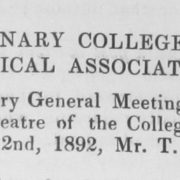
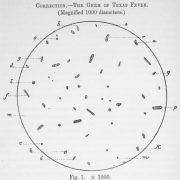
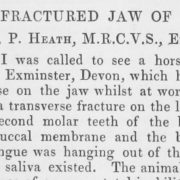
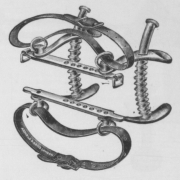
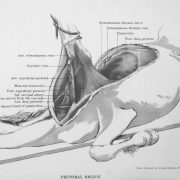
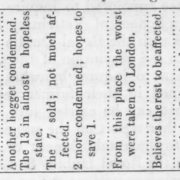
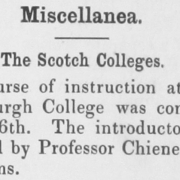
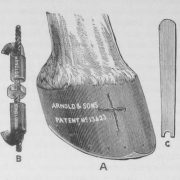


Leave a Reply
Want to join the discussion?Feel free to contribute!